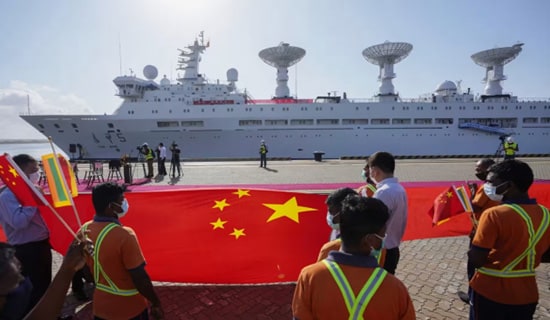The Chinese narrative has changed. Once renowned for its economic triumph, China is now famed for its economic slowdown and structural defects. The situation is so precarious that many question whether the Chinese Communist Party (CCP) has both the financial bandwidth and political flexibility to climb out of its self-inflicted circumstances.
The problems that plague the communist nation are vast. They include a massive debt problem, a shrinking and rapidly aging workforce, a property bubble, capital flight, trade sanctions, an unsustainable Belt and Road Initiative (BRI), eroding competitiveness, environmental degradation, and an acute water shortage, among others.

(Source: X)
Debt, Infrastructure And The Property Sector
Debt is the most serious of China's problems. For decades, China relied on infrastructure building, financed by debt, to achieve break-neck GDP growth. It was fine during the early years when the projects were indeed needed. But China has become overbuilt and many of its new infrastructure projects are either underutilized or downright unnecessary. They are "malinvestments" that pay no productive dividends despite their steep price tags.
Debt was used to fuel the property sector. State and private companies amassed trillions of dollars in debt to finance an unprecedented building spree. Government encouraged this as it stimulated the economy. Some five years ago, however, supply had finally outpaced demand and property values began to plummet.
Problem is, as much as 70 percent of the net worth of Chinese households are tied-up in property. Hence, along with the drop in property values came the obliteration of personal wealth. This led to massive defaults on amortization/installment payments on properties purchased. For property developers, this was another nail in their coffin given that they were already reeling from poor sales and debts falling due. We have all heard of how the once formidable Evergrande and Country Garden property conglomerates fell into a cash crunch and consequently, defaulted on their loans. They are the giants among the hundreds of smaller property firms who find themselves in the same distressed situation.
SUPPORT OUR WORK


The China Evergrande Group was a Chinese property developer. The company filed for bankruptcy in the United States in 2023, and which was followed by a court-ordered liquidation in Hong Kong in January 2024. (Source: Reuters.com/business/view-china-evergrande-ordered-liquidate-by-hong-kong-court-2024-01-29/, January 29, 2024)

Country Garden is a property development company based in Guangdong, China. On March 13, 2024, the "struggling Chinese developer Country Garden Holdings said Wednesday it had failed to make a 96 million yuan ($13.3 million) bond interest payment due the previous day, entering a 30-day grace period in which it will try to avoid its first default on a yuan bond." (Source: Asia.nikkei.com/Business/Markets/China-debt-crunch/China-s-Country-Garden-misses-yuan-bond-payment-in-latest-setback, March 13, 2024)
Although the property sector comprises 30 percent of the Chinese economy, the CCP is unable to give it the lifeline it needs since government itself is drowning in debt. Neither can the CCP stimulate demand by lowering interest rates and down-payment requirements since the banking sector too is stressed. With no viable options, the CCP can only wait for demand to catch up with supply. This could take years.
Provincial governments are large contributors to debt too. In the Chinese system, provincial governments are mandated to remit 80 percent of their tax revenues to the national government. They get back the equivalent of only 50 percent as their internal revenue allotment. The national government pays for only 15 percent of social services. The balance of provincial government's financial needs are sourced through debt. This includes the funds needed to build expensive infrastructure projects in compliance with the CCP's mandate.
An then there is the BRI, a plan conceived from the devil's belly. It will be recalled that the BRI was designed to give China first dibs in sourcing scarce raw materials, to control vital infrastructure, to control trade routes, and to create new markets for Chinese products.
China targeted poor but resource rich and/or geographically strategic countries into the BRI program and wooed them with easy-to-obtain loans. Although the loans carried high interest rates, exploitative privileges for China and steep penalties (including seizure of sovereign territories) – many developing countries availed, attracted by easy money. Corruption is said to have played a role.
But here is the problem: China financed most BRI projects with borrowed money to the tune of one trillion dollars. Since many of the BRI projects were not viable in the first place, borrowers defaulted or requested to restructure when the debts fell due. China was left holding the debt.
All these, plus the avalanche of subsidies provided to state-owned enterprises, contributed to China's mountain of debt. As of last September, China's debts stood at 280 percent of GDP, a higher ratio than that of the U.S. China's debt has increased by four hundred percent in the last 12 years as the need to stimulate the economy through spending became more urgent.
Capital Flight And Flagging Consumption
Within two years, the CCP enacted a series of laws that spooked investors. They include: the updated Foreign Investment Law, which gives government the power to nationalize foreign assets; the new Counter Foreign Sanctions Law, which enables government to seize assets and detain expats; the Anti-Espionage Law, which broadened the definition of spying; and the Foreign Policy Law, which bestows upon Chinese companies the responsibility of acting as extensions of government, among others.
These repressive laws, coupled with the trend of the Western world to de-risk and/or de-couple from China, caused foreign investors to flee. For the first time in China's recent history, the People's Republic experienced a net outflow of investments amounting to $140 billion as of September 2023.
The exodus of investors would have been bearable if the Chinese could rely on local consumption to sustain their economy. But as mentioned earlier, the property bubble deflated personal wealth of households.
Worse, China's rapidly aging population caused those in the workforce to save the lion's share of their salaries to care for aging relatives. China has the largest precautionary savings rate in the world, consisting of 35 percent of their net worth. This leaves no room for consumption outside the basic essentials. Consumer spending accounts for just 30 percent of the Chinese economy, compared to 60 percent in Japan.
The above-mentioned factors, taken collectively, have put the Chinese economy in dire straits. The years of high growth are a thing of the past and China must deal with its structural problems if it is to restore its trend of high growth.
*Andrew J. Masigan is the MEMRI China Media Studies Project Special Advisor. He is a Manila-based economist, businessman, and political columnist for The Philippine Star. Masigan's articles in MEMRI are also published in The Philippine Star.




